‘The simpler it is, the harder it is to understand.’ This idiom fits viruses. Viruses are the most astonishing creation of nature. Despite their simple physical and molecular structure, they are the most abundant and the most adaptive living entities on Earth.
Life evolved from single-celled oceanic micro life about 3.7 billion years ago and reaches this period. During this 3.7 billion-year timeline, millions of species were created and wiped out from nature. There is nothing, known till, other than viruses that have seen all these changes, and no doubt, they will experience the company of many more species yet to evolve.
Interesting Science Videos
What are Viruses?
Viruses are obligatory parasitic infectious biological particles possessing only one type of nucleic acid and requiring the host cell’s mechanism to replicate. They are mostly defined as submicroscopic infectious agents with the capacity to replicate that are made from either RNA or DNA molecules surrounded by a protein coat.
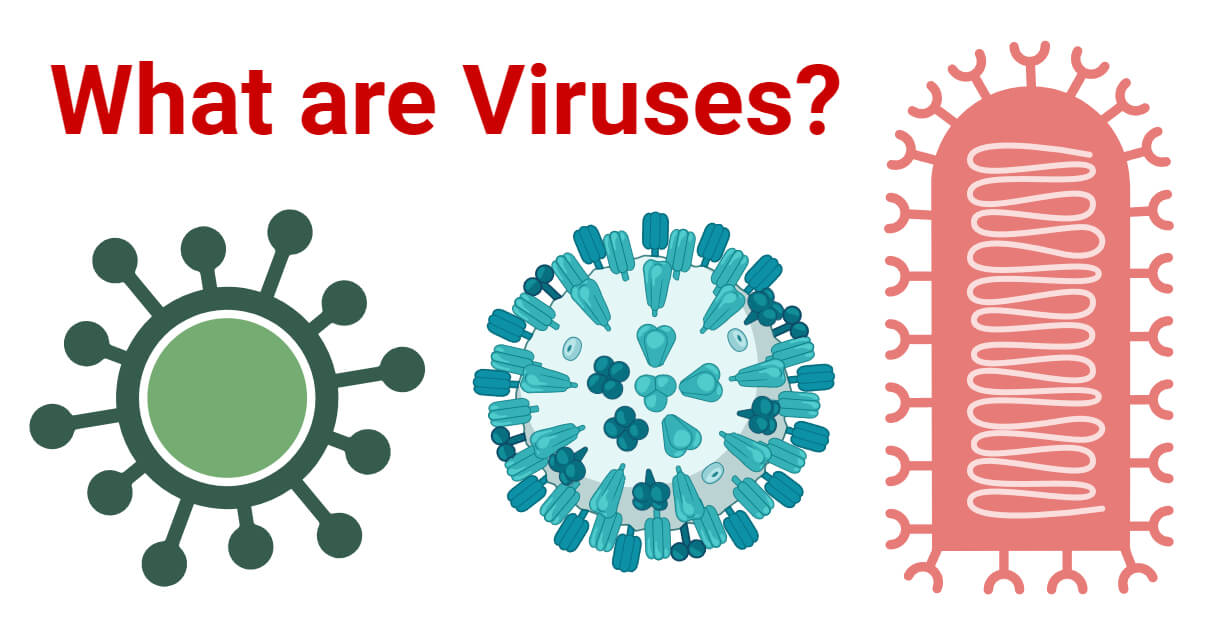
- The word ‘virus’ is derived from the Latin word ‘vīrus’ which means poisonous fluid or venom.
- The study of viruses is called virology and it is one branch of microbiology. However, viruses are not considered microorganisms. In fact, they are not even considered living things. ‘Are viruses living or dead?’ – This is one debatable question in biology. They exhibit characteristics of both living and non-living things, so instead of defining them as living or non-living, they are simply defined as the border between chemistry and life or between living and non-living.
- Viruses are the most abundant biological entities and are ubiquitous. They can infect every life form in existence and must have infected every extinct one too. Tobacco mosaic virus (TMV) is the first discovered virus discovered by Martinus Beijerinck in 1898. Since then, about 7000 types of viruses have been studied and well-described. It is estimated that more than a hundred million viral types may be present in nature and most of them are unknown to us (https://virology.ws/2013/09/06/how-many-viruses-on-earth/).
Origin and Evolution of Viruses
Since viruses are obligatory parasites and can’t live or multiply outside the host’s body, it is expected that viruses must have originated after the origin of the first cellular life form. However, there is debate among virologists on the origin of viruses regarding whether they appear before the last universal common ancestor (LUCA) or evolved after LUCA from the genes that escaped from the genome of LUCA.Three main hypotheses regarding the origin and evolution of viruses have been articulated; the progressive hypothesis, the regressive hypothesis, and the virus-first hypothesis.
- The Progressive Hypothesis
Also called the escape or the cellular origin hypothesis, the progressive hypothesis states that viruses originated from the mobile genetic elements that escaped from the genome of the ancient cellular life or LUCA and evolved progressively. However, this hypothesis fails to explain the unique structures (capsid and others) present in the viruses but not in other cells.
- The Regressive Hypothesis
This hypothesis is also called ‘the reduction hypothesis’ or ‘the degeneracy hypothesis’. It states that viruses were initially small parasitic cells that in time lost all their genetic and cellular components that were not required for the parasitic mode of life and regressively evolved to the current form. The prominence of genes in viruses without cellular counterparts is one major critique of this hypothesis. Additionally, besides viruses, no other, even the smallest parasites, resemble viruses in any way.
- The Virus-first Hypothesis
This hypothesis states that viruses existed since the precellular world way before archaea, bacteria, or eukarya. During the period when inorganic molecules were aggregating and reacting to form organic molecules and thus formed organic molecules were aggregating to form a living entity, viruses may have been created from the aggregation of proteins and nucleic acids. Over time, enzymes for synthesizing membranes, cell walls, and other cellular components evolved forming a true cell, but viruses remained in their acellular form and gained the capacity to infect cellular life and replicate. However, if we accept this hypothesis, then we have to change the definition of virus and seek an answer to a question – how do the very first viruses replicate and survive without host cells?
Ecology and Habitat of Viruses
Viruses are ubiquitous – found in air, water, and soil, where cellular life form exists. They are isolated from everywhere including polar ice to hot water vents or volcanic regions, deep oceans to rocks of deserts, acidic lakes to hyper alkaline and hypersaline salt lakes, etc.
Even though viruses do not metabolize themselves, viruses, especially phage viruses, are considered crucial in maintaining food webs and regulating biogeochemical cycles. Viruses lyse the bacterial cells and release about 20% of the carbon fixed into the pool of dissolved organic matter (DOM) and particulate organic matter (POM). These DOM and POM are consumed by more microorganisms, recycled, and transferred to higher trophic levels whereas some are again released into the pool by viral lysis. Ironically, the viral lysis of bacteria leads to a larger bacterial population and limits the transfer of organic matter to higher trophic levels. This loop of transfer of organic carbon continues endlessly and viruses play a very important role. (reference: O’Malley, M. A., The ecological virus, Studies in History and Philosophy of Biological and Biomedical Sciences (2016), http://dx.doi.org/10.1016/j.shpsc.2016.02.012 )
Molecular Structure of Viruses
Viruses are simple in design. An extracellular, complete, infectious stage of a virus is called a virion. In general, a virion consists of a viral genome (RNA or DNA) surrounded by a protein coat called capsid. Some virions may contain envelope derived from the host’s plasma membrane.
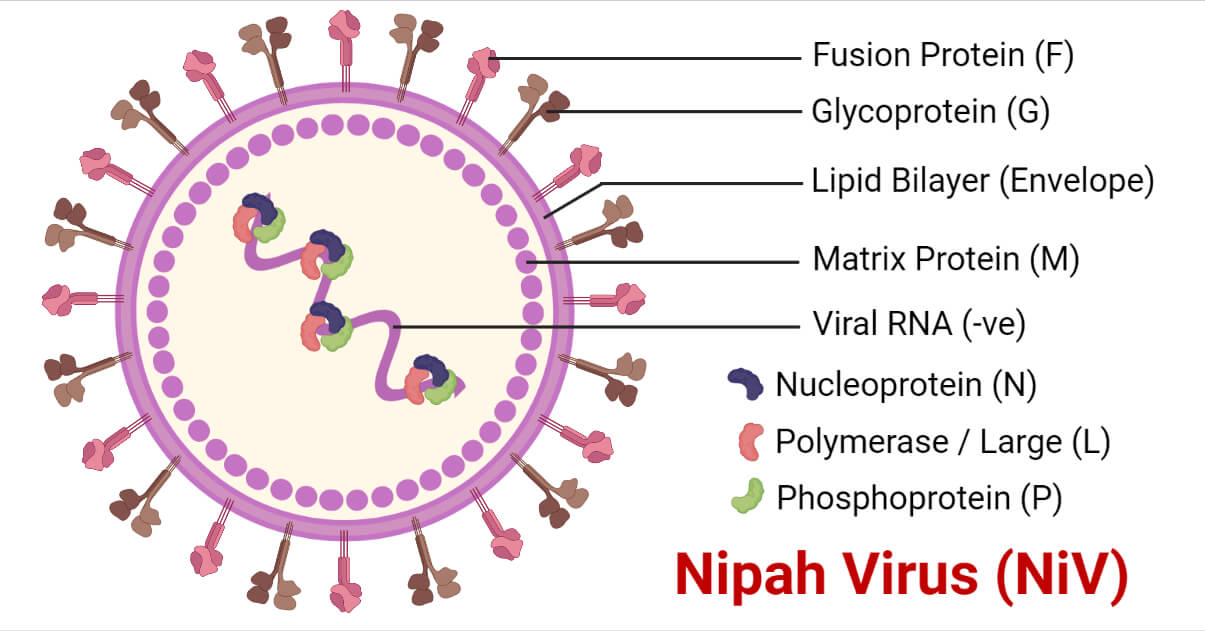
1. Nucleic Acid (Viral Genome)
A virion contains only one type of nucleic acid, either DNA or RNA, as its genome but never both. Viruses containing RNA as their genome are called RNA viruses and viruses containing DNA as their genome are called DNA viruses. Most viral genomes are within 7 to 20 kbp long; however, they may range from 3 kbps to over 1.2 Mbps.
The nucleic acid may be single-stranded or double-stranded. Double-stranded RNA and single-stranded DNA are also found in many viruses. The viral DNA may be linear or circular. A virion may contain a single RNA or several segments of RNA. The viral RNA may also be classified as positive or negative sense RNA. Positive sense RNA is known to have a 5’ to 3’ RNA genome and can be readily translated into proteins. However, a negative-sense RNA is known to have a 3’ to 5’ RNA genome that can’t be readily translated into proteins and needs to be transcribed to positive-sense RNA before translation.
2. Capsid
The viral genomes are externally coated by a shell of proteins called capsid. Capsid is a polymeric structure made of structural subunits called capsomers which in turn are made of different kinds of proteins. These proteins forming capsomers are encoded by the viral genome and are translated inside host cells using the host’s protein-synthesizing machinery. Capsid together with enclosed nucleic acid is termed as nucleocapsid. Capsid protects the viral genome from any physical or chemical stresses, contains attachment sites to adhere to the host cell, and helps to penetrate the host cell.
3. Envelope
Some viruses are externally covered by a lipid bilayer membrane called an envelope. Viral envelopes are derived from the host’s plasma membrane; hence, they are composed of lipid bilayers as in the plasma membrane. Additionally, virus-encoded virus-specific proteins (glycosylated membrane proteins), also called matrix proteins, are also found in the viral envelope. These membrane proteins are often demonstrated as viral spikes or knobs projecting outside the viral envelope.
Shape and Size of Viruses
Viruses display a wide diversity in their shape and size. Some may be as small as 20 nm in diameter while some may reach up to 1400 nm in length and 80 nm in diameter. Giant viruses measuring up to 400 nm in diameter have also been discovered.
The viral capsid generally has two basic symmetry or structures viz. helical or icosahedral structure. Hence, most viruses are morphologically either helical or icosahedral, although, a few have complex structures.
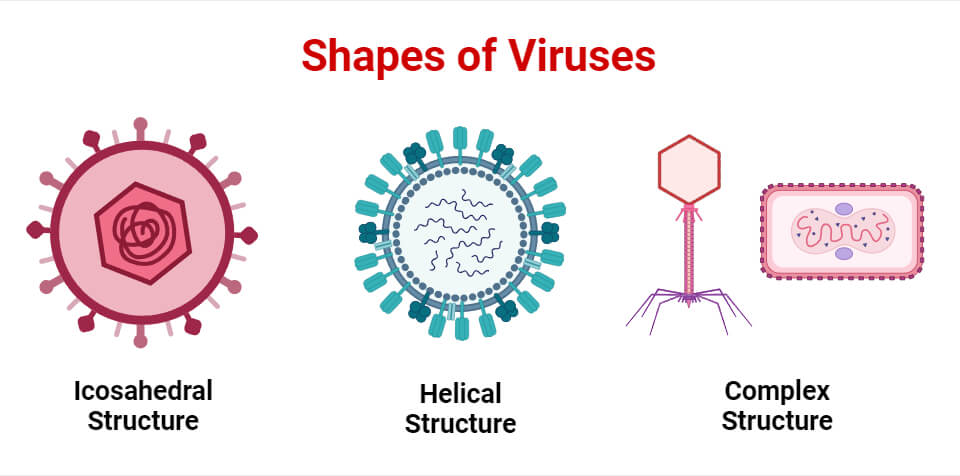
1. Icosahedral Structure
An icosahedron is a geometrical shape with 20 faces each in the shape of an equilateral triangle. They nearly appear spherical in shape and initially, they were considered spherical; however, electron microscopy suggested that they are actually icosahedral. Icosahedral structure, also known as cubical structure, is the predominant shape of animal viruses. Many of the animal icosahedral viruses are enveloped whereas most of the plant viruses are naked.
Each triangular face is made of at least 3 capsomers, so at minimum 60 capsomers can form an icosahedron structure. In such viruses, their genome is completely packed inside the icosahedron capsid.
Examples of icosahedral viruses include hepatitis B virus, dengue virus, parvovirus, rhinovirus, human papillomavirus, herpes virus, etc.
2. Helical Structure
It is a spiral shape in which capsid curves cylindrically around a central axis (nucleic acid core). In helical viruses, the viral genome coils helically and the capsid proteins helically wind around the viral genome forming an elongated (tube/rod-like in structure) nucleocapsid.
The length of the capsid and the number of capsomers depends on the length of the viral genome. Helical viruses typically have shorter genomes because only one type of capsomer is required and hence only one type of gene is required to code for capsid. Additionally, helical viruses are energy efficient as they require less free energy to assemble capsid than required by icosahedral or complex viruses. Enveloped helical viruses are mainly animal viruses. Most of the well-defined helical viruses are plant viruses and the majority of them are naked.
Examples of helical viruses include Tobacco mosaic virus, influenza virus, measles virus, mumps virus, rabies virus, Ebola virus, etc.
3. Complex Structure
A few viruses show unique architectures that are neither helical nor icosahedral. Such structures are called complex structures. Bacteriophages, poxviruses, geminiviruses, etc. show complex structures.
Poxviruses have brick-shaped enveloped viruses whose capsid is dumbbell-shaped and is surrounded by two lateral bodies of currently unknown function.
Many bacteriophages have icosahedral heads connected to cylindrical tail sheaths.
Similarly, geminiviruses have two icosahedral heads connected to each other.
Classification of Viruses
There are different systems to classify viruses among which Baltimore classification and ICTV classification systems are generally accepted systems.
As per the report of April 2023, ICTV (International Committee on Taxonomy of Viruses) authorized a 15-rank hierarchal taxonomy for viral classification. This classification is based on chemical and physical properties of viruses like genome type, number of proteins encoded, nucleic acid sequence, virion shape, capsid shape, envelop, etc. However, in general, only four taxonomic ranks viz. order, family, genus, and species are widely used. The viral species can further be classified into different strains, variants, biotypes, serotypes, or isolates.
| Taxonomic Rank | Numbers of Taxa | Mandated Suffix for Taxa |
| Realm | 6 | – viria |
| Subrealm | 0 | – vira |
| Kingdom | 10 | – virae |
| Subkingdom | 0 | – virites |
| Phylum | 17 | – viricota |
| Subphylum | 2 | – viricotina |
| Class | 40 | – viricetes |
| Subclass | 0 | – viricetidae |
| Order | 72 | – virales |
| Suborder | 8 | – virineae |
| Family | 264 | – viridae |
| Subfamily | 182 | – virinae |
| Genus | 2,818 | – virus |
| Subgenus | 84 | – virus |
| Species | 11,273 | Non applicable |
Reference: Stuart G Siddell, Donald B Smith, Evelien Adriaenssens, Poliane Alfenas-Zerbini, Bas E Dutilh, et al.. Virus taxonomy and the role of the International Committee on Taxonomy of Viruses (ICTV). Journal of General Virology, 2023, 104 (5), pp.001840. ff10.1099/jgv.0.001840ff. ffpasteur-04117907
Another popular classification scheme is the ‘Baltimore Classification System’ devised by Nobel laureate David Baltimore in 1970 based on the type of nucleic acid genome and replication strategy of the virus. According to this system, viruses are classified into 7 classes as;
- Class I: dsDNA viruses
- Class II: ssDNA viruses
- Class III: dsRNA viruses
- Class IV: positive sense ssRNA viruses
- Class V: negative-sense ssRNA viruses
- Class VI: RNA viruses that reverse transcribe
- Class VII: DNA viruses that reverse transcribe
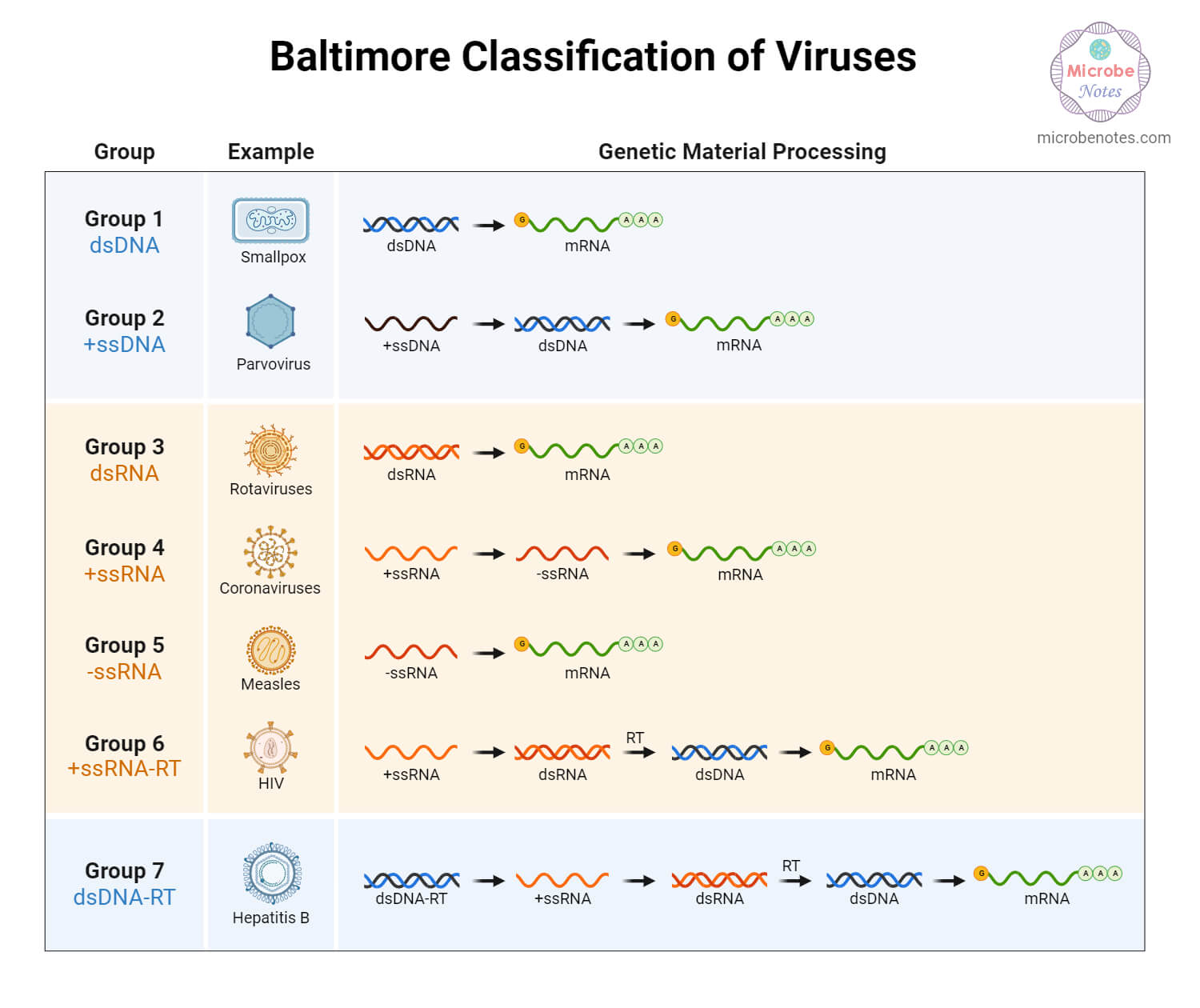
Replication (Reproduction) in Viruses
Despite their acellular nature and lack of cellular organizations, viruses can replicate and increase their number. To do so, they are totally dependent on the host’s metabolic and protein-synthesizing machinery (nucleic acids, ribosomes, and enzyme system). Different viral species have different replication cycles but, the overall replication can be broken down into the following 7 basic stages:
1. Attachment
The plasma membrane or cell wall of the host cell contains several cell surface molecules made of glycoproteins or glycolipids. Different types of glycoproteins and glycolipids, besides their normal functioning, serves as cell surface receptor for viral attachment. The virus attachment proteins (VAP) present in the capsid or envelope of viruses interact with specific cellular receptor molecules (usually glycoprotein and carbohydrate residue of glycoprotein or glycolipid) present on the host’s cell establishing host-virus interaction.
Different viruses use different surface receptors for attachment. For instance, HIV-1 uses CD4 influenza viruses use terminal sialic acid residues, poliovirus use PVR CD155, etc.
2. Penetration
Following attachment, the virus particle crosses the plasma membrane and enters the host’s cytoplasm. This process of crossing the membrane barrier is called penetration and it requires metabolic energy. For penetration, viruses mainly use three mechanisms: i) receptor-mediated endocytosis, ii) fusion, and iii) translocation.
Receptor-mediated endocytosis is the commonly used mechanism of viral penetration. Clathrin-mediated endocytosis, caveolin-mediated endocytosis, non-clathrin non-caveolin endocytosis, bulk-phase endocytosis, and phagocytosis are well-known methods.
Several enveloped viruses use the fusion method to enter a host cell. The viral envelope fuses with the host’s plasma membrane due to the action of viral fusion proteins. The fusion allows viral nucleocapsid to enter the host cell.
Translocation of the entire virion is rarely observed in some viruses and it is the least understood mechanism.
3. Uncoating
Uncoating refers to the process of partial or complete degradation of viral capsid releasing viral genome into the host’s cytoplasm. Uncoating may occur simultaneously along with or just after penetration. In bacteriophages, penetration and uncoating are the same things as they directly inject their genome inside the bacterial cell leaving a capsid coat outside.
4. Replication
It is the stage where the viral genome is replicated and viral proteins are expressed in order to create new virions. The replication process of a virus depends upon its genome type.
Members of each 7 classes of virus, as described in Baltimore’s classification, follow different replication strategies; hence in total 7 different viral replication strategies can be found. Regardless of the strategy, they all copy their genome and translate viral proteins. In general, most DNA viruses enter the host’s nucleus, and their genome is replicated inside the host’s nucleus while most RNA viruses replicate outside the host’s nucleus. The viral genome is first expressed to synthesize viral proteins and then the genome is either replicated (for DNA) or transcribed (for RNA) to produce numerous viral genomes.
5. Assembly
The viral proteins and genome created during the replication stage come together at a specific site and assemble to form an immature viral particle. The site of assembly may be different in different viruses and is dependent on the replication strategy and mechanism of viral release. Mostly, viral assembly occurs in the cytoplasm.
The enveloped viruses congregate at the inner side of the host’s membrane (membrane of nucleus, ER, Golgi complex, or even plasma membrane) forming a bud. During this stage, they embed their envelop proteins in the host’s lipid membrane. From the membrane of this area, enveloped viruses get their lipid bilayer envelope.
6. Maturation
Once viral nucleocapsid is assembled, there undergoes different structural and conformational changes in viral proteins and capsomers. This change is referred to as maturation and results in the formation of infective virus particles.
7. Release
It is the final stage where newly formed virions exist in the host cell. The already enveloped viruses generally are released via exocytosis; whereas, those enveloped viruses that are congregated at the host’s plasma membrane are released via budding mechanism.
Nonenveloped (naked) viruses are released either by lytic mechanism (bursting the host cell) or by exocytosis mechanism.
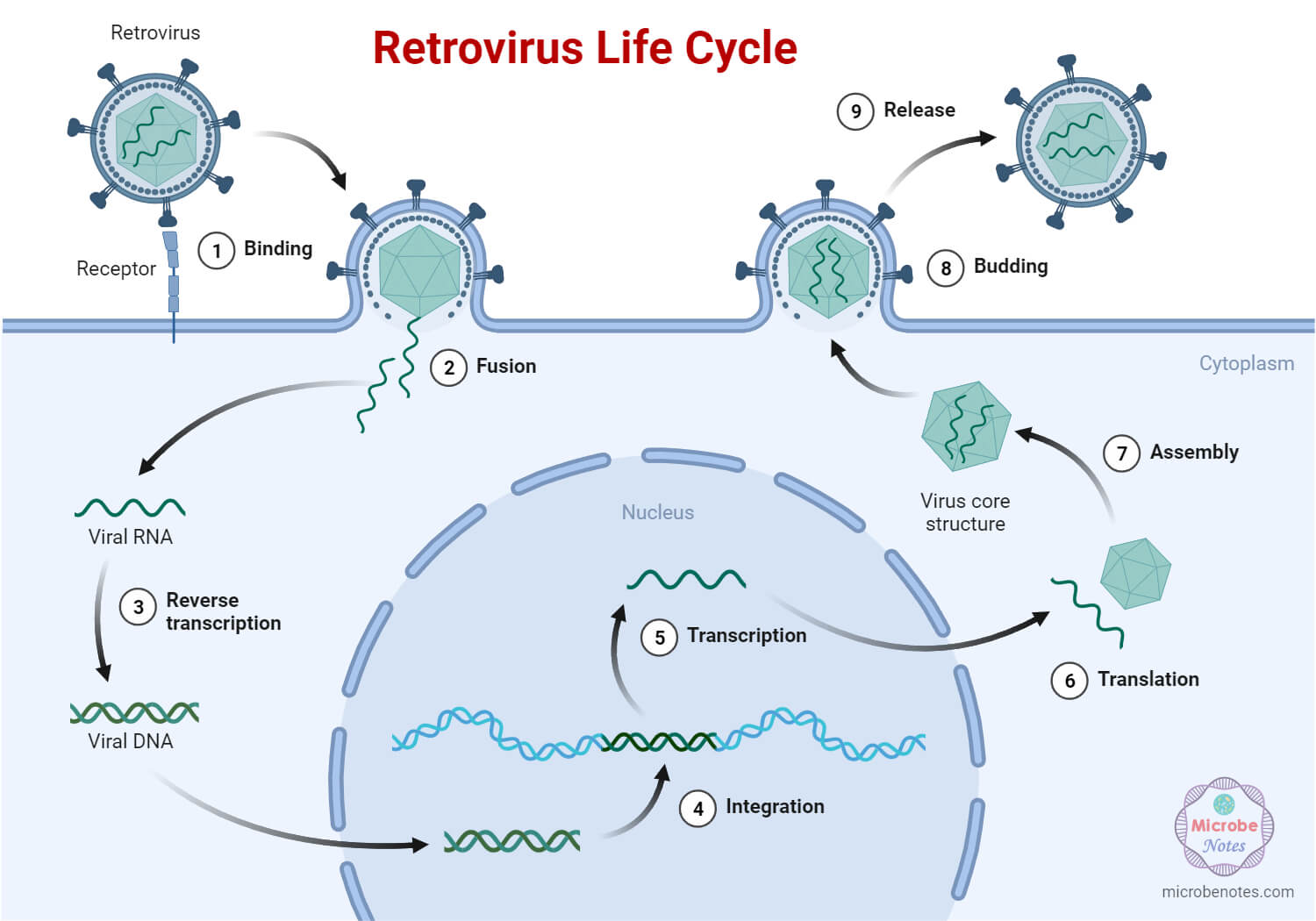
Significance of Viruses
- Viruses are the major causes of disease in all life forms including humans. They are even associated with different kinds of cancer. It is believed that viruses are one of the main components to cause the extinction of many species and the evolution of new ones.
- Viruses are also being studied as therapeutic agents to treat cancer and genetic disorders and to kill pathogenic microorganisms (like phage therapy).
- Viruses play an important role in maintaining the ecosystem. In aquatic environments, viruses are the most abundant entities and they help to regulate biogeochemical cycles and maintain aquatic microbiome and aquatic ecosystem.
- Viruses are used as vectors in biotechnology to deliver genes coding desirable characteristics to the genome of the recipient cell.
- Viruses can be used as natural pesticides and insecticides.
Viruses- Living or Dead?
Viruses exhibit characteristics of both living and non-living things; hence, it is unclear to claim either they are living or non-living. Instead, they are considered a border between living and non-living and often defined as acellular particle.
| Living Characteristics of Viruses | Non-living Characteristics of Viruses |
| Reproduction (ability to replicate) | Lack of cellular organization |
| Presence of nucleic acid | Lack of metabolic machinery |
| Susceptible to mutation | Lack of autonomous reproduction |
| Ability to adapt to changing environment | Ability to crystalize |
| Nonresponsive to stimuli | |
| Lack of growth |
Viral Diseases in Human
Humans are susceptible to different pathogenic viruses and time and again humanity has suffered from different viral epidemics. Some common viral diseases and associated viral species are tabulated below:
| Human Viral Disease | Causative Agent |
| Common cold | Rhinovirus, coronavirus, RSV, parainfluenzae virus |
| SARS-CoV, SARS-CoV2, MERS | Coronaviruses |
| Rabies | Rabies virus (Lyssavirus) |
| Chickenpox, Smallpox | Pox viruses |
| Hepatitis | Hepatitis viruses |
| Dengue | Dengue viruses |
| Chikungunya | Chikungunya virus |
| Influenza | Influenza viruses |
| Poliomyelitis | Poliovirus |
| Encephalitis and Meningitis | Japanese encephalitis virus (JEV), Human polyomavirus 2, arbovirus |
| Viral Conjunctivitis | Adenovirus, HSV |
| Pneumonia | RSV, Influenza virus Types A and B, coronaviruses, adenovirus |
| HIV-AIDS | HIV |
| Gastroenteritis | Rotavirus, Adenovirus, Noroviruses |
References
- Nasir, A., Romero-Severson, E., & Claverie, M. (2020). Investigating the Concept and Origin of Viruses. Trends in Microbiology, 28(12), 959-967. https://doi.org/10.1016/j.tim.2020.08.003
- Sinkovics J, Horvath J, Horak A. The origin and evolution of viruses (a review). Acta Microbiol Immunol Hung. 1998;45(3-4):349-90. PMID: 9873943.
- Mirza, A. Z., Shamshad, H., Osra, F. A., Habeebullah, T. M., & Morad, M. (2020). An overview of viruses discovered over the last decades and drug development for the current pandemic. European Journal of Pharmacology, 890, 173746. https://doi.org/10.1016/j.ejphar.2020.173746
- Bell, P. J. L. Viral eukaryogenesis: Was the ancestor of the nucleus a complex DNA virus? Journal of Molecular Evolution 53, 251–256 (2001) doi:10.1007/s002390010215.
- Wessner, D. R. (2010) The Origins of Viruses. Nature Education 3(9):37
- O’Malley, M. A., The ecological virus, Studies in History and Philosophy of Biological and Biomedical Sciences (2016), http://dx.doi.org/10.1016/j.shpsc.2016.02.012
- Forterre, P. (2006). The origin of viruses and their possible roles in major evolutionary transitions. Virus Research, 117(1), 5–16. doi:10.1016/j.virusres.2006.01.010
- Stuart G Siddell, Donald B Smith, Evelien Adriaenssens, Poliane Alfenas-Zerbini, Bas E Dutilh, et al.. Virus taxonomy and the role of the International Committee on Taxonomy of Viruses (ICTV). Journal of General Virology, 2023, 104 (5), pp.001840. ff10.1099/jgv.0.001840ff. ffpasteur-04117907
- Zerbini, F.M., Siddell, S.G., Lefkowitz, E.J. et al. Changes to virus taxonomy and the ICTV Statutes ratified by the International Committee on Taxonomy of Viruses (2023). Arch Virol 168, 175 (2023). https://doi.org/10.1007/s00705-023-05797-
- Fauquet, C. M. (1999). TAXONOMY, CLASSIFICATION AND NOMENCLATURE OF VIRUSES. Encyclopedia of Virology, 1730-1756. https://doi.org/10.1006/rwvi.1999.0277
- Louten, J. (2016). Virus Structure and Classification. Essential Human Virology, 19-29. https://doi.org/10.1016/B978-0-12-800947-5.00002-8
- Varanda, C., Félix, R., Campos, M. D., & Materatski, P. (2021). An Overview of the Application of Viruses to Biotechnology. Viruses, 13(10). https://doi.org/10.3390/v13102073
- Sandaa, A., & Bratbak, G. (2018). Is the Virus Important? And Some Other Questions. Viruses, 10(8). https://doi.org/10.3390/v10080442
- Nasir, A., Kim, K. M., & Caetano-Anollés, G. (2012). Viral evolution: Primordial cellular origins and late adaptation to parasitism. Mobile Genetic Elements, 2(5), 247-252. https://doi.org/10.4161/mge.22797
- Koonin, E. V., Senkevich, T. G., & Dolja, V. V. (2006). The ancient Virus World and evolution of cells. Biology Direct, 1, 29. https://doi.org/10.1186/1745-6150-1-29
- Cann, A. J. (2008). Replication of Viruses. Encyclopedia of Virology, 406-412. https://doi.org/10.1016/B978-012374410-4.00486-6
- https://www.immunology.org/public-information/bitesized-immunology/pathogens-disease/virus-replication
- Louten, J. (2016). Virus Replication. Essential Human Virology, 49-70. https://doi.org/10.1016/B978-0-12-800947-5.00004-1
- https://open.oregonstate.education/generalmicrobiology/chapter/introduction-to-viruses/
- Gelderblom HR. Structure and Classification of Viruses. In: Baron S, editor. Medical Microbiology. 4th edition. Galveston (TX): University of Texas Medical Branch at Galveston; 1996. Chapter 41. Available from: https://www.ncbi.nlm.nih.gov/books/NBK8174/
- Britannica, The Editors of Encyclopaedia. “virus summary”. Encyclopedia Britannica, 22 Sep. 2021, https://www.britannica.com/summary/virus. Accessed 20 September 2023.
- https://journals.asm.org/doi/10.1128/jvi.02203-10
- https://www.inspiritvr.com/general-bio/prokaryotes-and-viruses/origin-of-viruses-study-guide
- Virus. (2023, September 7). In Wikipedia. https://en.wikipedia.org/wiki/Virus
- Hurst, C. J. DEFINING THE ECOLOGY OF VIRUSES. 1-48. https://doi.org/10.1002/9781119608370.ch1
- Parvez, M. K. (2020). Geometric architecture of viruses. World Journal of Virology, 9(2), 5-18. https://doi.org/10.5501/wjv.v9.i2.5
- https://virology.ws/2013/09/06/how-many-viruses-on-earth/
- https://www.merriam-webster.com/dictionary/virus
- https://micro.magnet.fsu.edu/cells/virus.html
- https://bio.libretexts.org/Bookshelves/Introductory_and_General_Biology/Introductory_Biology_(CK-12)/07%3A_Prokaryotes_and_Viruses/7.08%3A_Virus_Structures

Excellent compilation of information